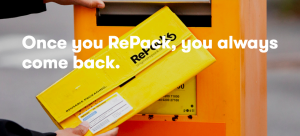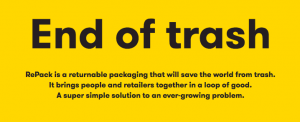After discussing Repack in class today, I could not help but look into the company a bit more to discover how this business functions and how feasible it seems. Once I have outlined the company’s current procedures and scope, I will apply aspects of the Supply Chain Operations Reference (SCOR) model, to demonstrate ways that I believe the company can have a greater sustainable impact.

So far, there are 30 stores that offer the RePack option and 50,000 customers have used this service when making their respective purchases. The packaging is designed to survive at least 20 cycles and is designed specifically for clothing purchases. Another differentiating factor of this product, other than being reusable, is that it is adjustable. This feature ensures that the air can be removed from the packaging, which saves more money and nature as transportation becomes more efficient.
One weakness of this service highlighted by the website is that the return rate is only 75%. This means that out of the 50,000 purchases that have used the RePack shipping option, only 37,500 of the packages were returned. The question is not only an issue for the company’s costs, but also for the disposal after use. Considering that these packages are more durable than a standard envelop, is it possible that they could have a greater negative impact if they end up in the landfill? A claim made on the website is that “it reduces C02 by 80%” but I am curious if this is the case considering those packages that are “lost.”

Something this company does extremely well is highlight the social sustainability aspect, in terms of strengthened relationships. They have proven that customers that use Repack are far more likely to be repeat customers, bettering the bond between the customer and the company. This connection is something that is much more difficult to develop in the ecommerce setting.

Using aspects of the SCOR model, I have created a list of the current strengths and potential considerations for the development of this company (in bold):
Environmental
- Design and Plan: Designed for multiple uses/reuses
- Source: Sources recycled material for the creation of the product
- Deliver: Packaging is returnable to improve fuel efficiency
- Use and Return: Successfully creates reverse-logistics channels, but needs a plan for the 25% of packages that are not returned.
Social
Overall, the social aspect of the SCOR model is not the strong point for RePack. The majority of barriers are related to the fact that this is a relatively new company that requires expansion. Therefore, the suggestions for social betterment are listed below.
- Deliver: Currently, the company is reaching out to companies to form partnerships and spread the use of the RePack shipping solution. However, the company must look to expand its use beyond Europe, as currently only European companies are engaged.
- Use and Return: Find a way to increase the percentage of packages returned. Also, ensure that there is a plan for end-of-life, once the 20+ uses have occurred.
Economic
- Make: RePack will definitely have to look into investing in geographic manufacturing hubs to help improve supply chain efficiency if expanding into other continents.
They would also benefit from taking advantage of economies of scale by expanding into other locations and potentially expanding the product offerings- greater variety in package sizing.
While there are improvements that need to be made, I have to say that this is a pretty awesome innovation. I am hoping that stores I frequently buy from start to use this system so that I am no longer left with the guilt of the waste that comes with my purchases.
Thanks for providing some awesome insight into the SCOR model and it’s actual applications. This really helped me figure out Re-Pack’s model and I think it is an amazing option to reduce unsustainable packaging waste. The fact that the option will hopefully be widely available soon really helps deal with the guilt surrounding packaging for green consumers. However, I think the point you made about the packaging’s return rate is an extremely pertinent one. This packaging ending up in landfills is literally the worst case scenario but is still an extremely real threat that could seriously negatively impact the good this company is trying to do. It is always encouraging to see businesses attempt to tackle issues like these and simultaneously make it easier for other businesses to provide more green services though.